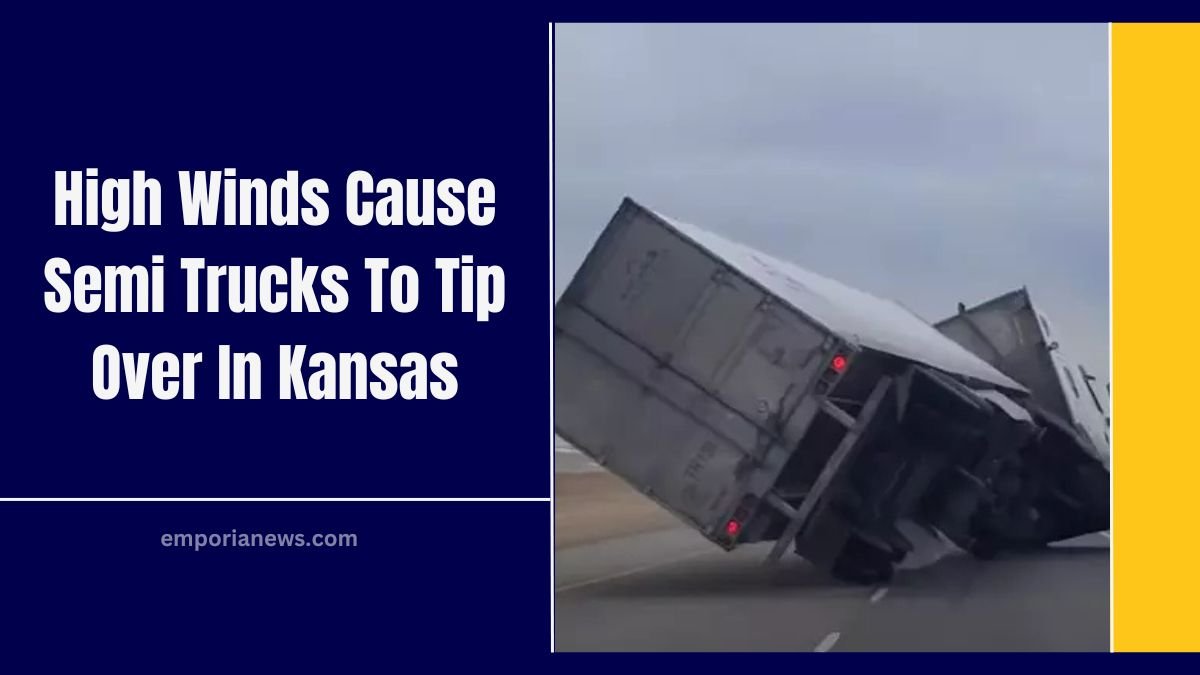Kansas has been experiencing powerful high winds in recent days, which have resulted in semi-truck crashes, causing traffic disruptions and minor injuries.
On Wednesday, the Kansas Highway Patrol (KHP) responded to several incidents where semi trucks were tipped over by strong wind gusts, creating hazardous conditions on the roads.
Here’s a detailed look at the impact of the winds and the crashes in Saline and Kingman counties.
High Winds in Kansas: The Impact on Semi Trucks
The weather in Kansas on Wednesday included some dangerously strong wind gusts. Wind gusts as high as 60 mph were reported in several areas, causing significant problems for drivers, especially for large vehicles like semi trucks.
These vehicles, due to their size and height, are particularly vulnerable to high winds, making it difficult for drivers to maintain control.
Notable Incidents in Kansas:
| Location | Incident | Driver Details | Wind Gusts | Injuries |
|---|---|---|---|---|
| Saline County | Semi-truck overturned on I-70 due to high winds | 66-year-old man from Salina | Gusts of 60-65 mph | Minor injuries suspected |
| Kingman County | Semi-truck tipped onto its side on US-54 in high winds | 44-year-old man from Wichita | Gusts of 60-65 mph | Minor injuries suspected |
| Shawnee County | Max wind speed recorded at 51 mph at 5:05 p.m. | N/A | Max gust of 51 mph | No direct accidents |
| Salina | Wind gusts of 66 mph recorded at 1:53 p.m. | N/A | Gusts up to 66 mph | No direct accidents |
How Do High Winds Affect Semi Trucks?
High winds are particularly dangerous for semi trucks because of their large, tall, and heavy design. Semi trucks can easily tip over when winds exceed 50 mph, especially on open highways or bridges.
The Kansas Highway Patrol (KHP) reports that winds in the range of 60-65 mph are generally considered damaging and capable of causing serious accidents, especially for large vehicles. The impact of such wind gusts can lead to:
- Loss of Control: High winds can cause semi trucks to swerve, especially when they are hauling large trailers.
- Overturning: As seen in the incidents in Saline and Kingman counties, high winds can tip over semi trucks, potentially causing road blockages and significant delays.
- Reduced Visibility: Wind gusts can stir up dust or debris, reducing visibility on the roads, especially in rural areas.
Details of the Incidents
Saline County Incident:
In Saline County, a 66-year-old man was driving a semi-truck hauling a trailer on westbound I-70 when a strong wind gust caused the vehicle to overturn.
The incident occurred on the highway, which is a major route in Kansas. The Kansas Highway Patrol reported that the driver had suspected minor injuries and was treated on-site.
Kingman County Incident:
A similar incident occurred in Kingman County, where a 44-year-old Wichita man was driving a semi-truck westbound on US-54 when high winds caused the truck to tip onto its side.
The truck slid into the median, and fortunately, the driver only sustained suspected minor injuries. This crash serves as another reminder of how dangerous high winds can be on open roads.
Wind Gusts in Kansas
On the day of the crashes, winds were particularly strong across the state. According to 27 News Meteorologist Ely Millard, wind gusts reached speeds of up to 60 mph in several areas.
These winds are typically considered damaging, especially when sustained over longer periods of time. The Shawnee County area recorded a maximum wind speed of 51 mph, while Salina recorded an even higher wind gust of 66 mph.
Such wind speeds create dangerous conditions for all drivers, especially those operating large trucks.
The recent high winds in Kansas have proven to be hazardous, particularly for semi trucks, which are at a higher risk of tipping over when faced with gusty conditions.
The Kansas Highway Patrol worked diligently to manage the aftermath of these incidents, with both drivers reported to have minor injuries. As wind gusts continue to reach dangerous levels, drivers are urged to take extra precautions when operating large vehicles.
Staying informed about weather conditions and adjusting driving habits accordingly can help prevent such accidents in the future.




